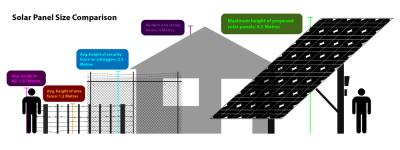Helensville and Greytown Hold Line against Solar Tsunami while elected stay gagged
Solar power station coverage of dairy pasture is a policy win-win for the government. The first win is for its renewables scheme. The second is by eliminating the cows blamed for creating half New Zealand’s greenhouse gases.
The halve-the-herd cry is routinely on the lips of activists unconcerned by the fact that the dairy industry is the nation’s chief export earner.
Tourism was the runner-up man foreign currency earner until Covid restricted world travel. Its recovery is now threatened by solar carpeting such heritage areas as Helensville and Greytown.
Concerned residents in the threatened towns are worried about the idealised artists impressions of these power stations which portray shoulder-high panels widely separated and with sheep grazing on the ample verdant pasture beneath.
Their research (pictured above) shows a quite different picture of the mechanical structural configuration relative to its surroundings.
The standard bearer for the resistance is the township of Helensville which has quite literally been under siege since the end of 2021 when the extent to which it was to be surrounded by a solar site began to leak out.
The point man for the entire resistance movement is Marco Scuderi
Mr Scuderi is a globally-recognised shipwright and yacht designer-builder who had no previous role in politics local or national.
So where exactly are the people elected and indeed paid to put a brake on exactly this type of state-backed disruption?
There is more. Suppression of public debate is through the government guiding the coverage of the topic in the mainstream media it does not directly control. This is achieved operationally through the Public Interest Journalism subsidy allocation system.
Greytown residents having discovered that a 500 acre solar power site was to be tacked onto its southern edges then proceeded to discover that another 500 acre generating plant had been tacked onto the other side of the town electricity substation – this time heading in the general direction of Martinborough another tourist town and famed for its vineyards.
The fact that New Zealand is embarking on its first generation of industrial capacity solar power stations is another camouflaged issue.
This because in this first flush of government-sponsored zeal there is no taking into consideration the negative aftermath of these plants installed a generation ago in the United States and which are described alarmingly in Michael Moore’s film Planet of the Humans.
With thousands of acres of dairy land in Waikato and Taupo designated for solar development the loss of export revenue set against the cost of importing all the solar equipment is an issue. Also sidestepped is the degree to which energy supply has been compromised by the political decision to turn off natural gas for instance.
There are substantially over 100 large scale solar site applications pending in New Zealand and this energy Klondike has much to do with planning regulations that make no distinction at all between pastoral farming and solar farming.
The government has set a solar forced march. It is underlined by the government’s disquieting willingness to dismantle the Covid immigration barriers for those able to accelerate the pace.
Neither is it too fussed about the people it tramples on in its swift advance.
Still, there must be surprise that the sternest resistance has come from places such as Helensville and Greytown both heritage grade retirement destinations.

